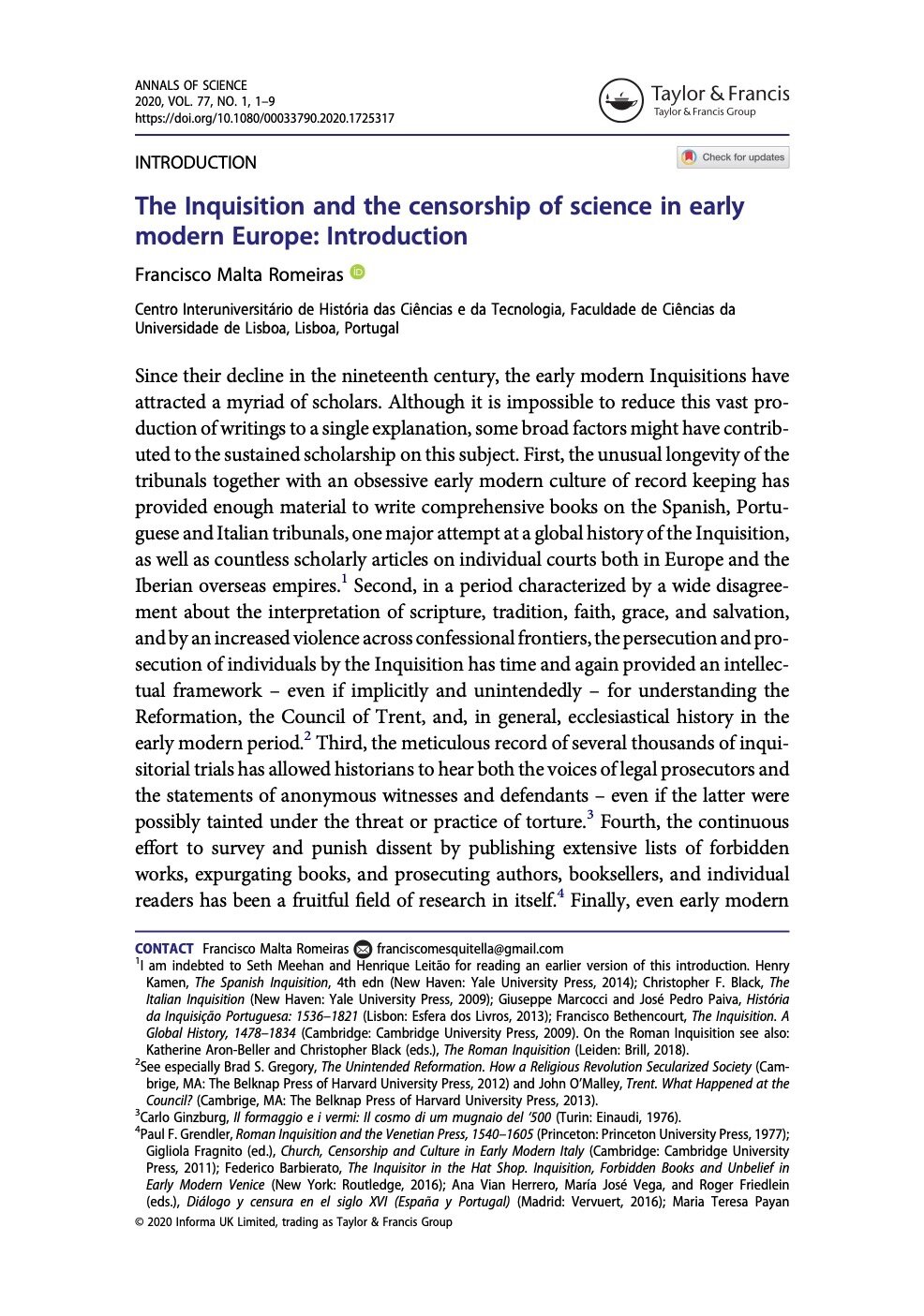The Inquisition and the censorship of science in early modern Europe: Introduction
- Autoria
- Ano
- 2020
- Periódico
Annals of Science, Vol. 77, N. 1
- Nº de Páginas
- 1-9

Parte do número especial "The Inquisition and the censorship of science in early modern Europe: Introduction", coordenado por Francisco Malta Romeiras.
Excerto do artigo (em inglês)
Since their decline in the nineteenth century, the early modern Inquisitions have attracted a myriad of scholars. Although it is impossible to reduce this vast production of writings to a single explanation, some broad factors might have contributed to the sustained scholarship on this subject. First, the unusual longevity of the tribunals together with an obsessive early modern culture of record keeping has provided enough material to write comprehensive books on the Spanish, Portuguese and Italian tribunals, one major attempt at a global history of the Inquisition, as well as countless scholarly articles on individual courts both in Europe and the Iberian overseas empires. Second, in a period characterized by a wide disagreement about the interpretation of scripture, tradition, faith, grace, and salvation, and by an increased violence across confessional frontiers, the persecution and prosecution of individuals by the Inquisition has time and again provided an intellectual framework – even if implicitly and unintendedly – for understanding the Reformation, the Council of Trent, and, in general, ecclesiastical history in the early modern period. Third, the meticulous record of several thousands of inquisitorial trials has allowed historians to hear both the voices of legal prosecutors and the statements of anonymous witnesses and defendants – even if the latter were possibly tainted under the threat or practice of torture. Fourth, the continuous effort to survey and punish dissent by publishing extensive lists of forbidden works, expurgating books, and prosecuting authors, booksellers, and individual readers has been a fruitful field of research in itself. Finally, even early modern scholars not concerned primarily with the history of the Portuguese, Spanish, or Italian courts often find themselves in regional and national archives and libraries with the records of inquisitorial trials, copies of expurgated books, and enquiries and procedures regarding the purity of blood of aspiring candidates. Understandably, inquisitorial sources are thus often integrated in larger stories of early modern history.
The history of the early modern Inquisitions has been a field of contention, ranging from the reliability of inquisitorial sources produced under the threat of torture (such as denunciations, confessions, and recantations), to the disputed existence of a crypto-Judaic community in the Iberian peninsula, to the motives behind the condemnation of Giordano Bruno to be burned at stake in 1600. The pervasiveness of a portrayal of the Inquisition as a monolithic institution that hindered economic and intellectual progress and led to the decline of Catholic countries in the seventeenth century, most notably Spain, owes much to the Leyenda Negra. Even though the Black Legend did not stem directly from the this portrait of the Spanish Inquisition, it was successfully incorporated in the general framework of Hispanophobia lending it further credence. Besides, the seminal works by Max Weber and Robert Merton that equated the birth of capitalism and modern science with the rise of Protestantism have reinforced the characterization of continental Catholic Europe as intellectually backward. The controversies surrounding the Inquisition have largely gone beyond the well-defined boundaries of academe. The popularity of Francisco Goya’s paintings, Fyodor Dostoevsky’s epic poem on ‘The Grand Inquisitor’, and Monty Python’s sketches on the ‘Spanish Inquisition’, for instance, have contributed to a portrayal of the Holy Office as intrinsically unlawful and immoral. In addition, the astounding unfamiliarity with the general contours of the Galileo Affair is representative of the gap between scholarly and popular spheres.